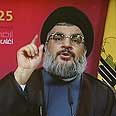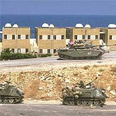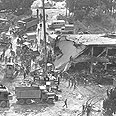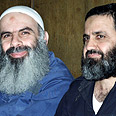




Hezbollah, the 'Party of God'
Founded in the early 1980s with the backing of the Iranian Revolutionary Guards, this Shiite Islamic fundamentalist organization is an armed political party with members in the Lebanese parliament. It is currently engaged in an intense power-struggle over Lebanon’s political future
Hezbollah’s chief stated objective is to establish Islamic rule over Lebanon according to the religious teachings of the late Iranian leader, Ayatollah Khomeini.
Hezbollah enjoys significant support from Lebanon’s Shia Muslims, called Metoualis, who despite constituting the largest religious sect in the country are disproportionately underrepresented in Lebanese state institutions.
Background
The Lebanese Shia experienced a social awakening following their involvement in the Lebanese civil war (1975-1977), Israel's Operation Litani (1978) and the 1982 Operation Peace for the Galilee, also knows as the first Lebanon War. The Shiites initially saw Israel's invasion into southern Lebanon as an opportunity to drive out the presence of the Palestinian Liberation Organization (PLO), but the initial sympathy for Israel was slowly replaced with disenchantment after it became apparent that Israel was holding political talks only with the ruling Christian hierarchy. In addition, there was growing Shia discontent with Israel's military presence in southern Lebanon, whose towns hold the largest concentrations of Shia communities in Lebanon.
Lebanon's political landscape modeled itself increasingly after the Iranian model. With the assassination of Bashir Gemayel and the expulsion of the PLO from Beirut in1982, Israel's hopes for a new Lebanese regime crumbled and Iranian-affiliated Shiites rose to even more prominence and power. It is with that Iranian support that Sheik Muhammad Hussein Fadlallah founded "'Hezbollah", designed to serve as Lebanon's vanguard against Israeli and American military presence in the country.
Though officially created in 1982, Hezbollah began to take shape in the city of Ba'albak in 1978. Unlike Amal, which championed domestic rights for Shiites, Hezbollah's ideology was of a far more radical nature. Its principal tenets were and remain: the establishment of an Islamic state modeled after Iran, independence from Western powers and an uncompromising resistance to Zionism. The two Shia organizations have a long and bloody history of political and armed clashes over their substantial ideological differences.
Organizational structure
Along with Fadlallah, Hezbollah's spiritual leadership was compromised of various key religious leaders and organization leaders who form the Shura Council. The secretary-general reports to the Shura. The secretary-general is charged with overseeing all of the organization's activities – military and otherwise.
The number of military operatives commanded by Hezbollah is estimated as several thousand, the number of civilian operatives acting on behalf of the organization is unknown but considered substantial.
Alongside its military agenda, Hezbollah maintains a vast network of community projects financed by untold dozens of millions of dollars. These include schools, hospitals, clinics, research facilities, kindergartens, various businesses and aid for the families of "Shahids" – martyrs. Public services are offered at no charge to local residents.
Hezbollah's chief benefactor continues to be Iran; however it also receives donations from various Shia communities throughout the world.
Evolution
Hezbollah truly began to garner strength in the 1980s as the Lebanese political system grew increasingly weaker due to the then permanent Syrian presence and influence over Lebanese affairs.Many in Syria still consider Lebanon as part of the concept of Greater Syria. The rule of Greater Syria generally includes Lebanon, Israel and Kuwait as well as the Sinai and provinces in Jordan, Iraq and Turkey.
High-profile terror attacks against Israeli and American targets in Lebanon also helped catapult Hezbollah’s standing within the general public. These attacks include the repeated bombings of the American embassy in Beirut in April 1983 (63 dead) and again in September 1984 (20 dead). Perhaps the most infamous of these attacks is the bombing of the US Marine barracks in October 1983 - 241 American servicemen were killed.
The Israeli headquarters in the port-city of Tyre was also attacked several times, 29 people were killed in the worst bombing in November 1983.
The subsequent US decision to withdraw from Lebanon was heralded by most Shiites as a massive victory for Hezbollah, as was the Israeli withdrawal to the security buffer zone in southern Lebanon in 1985. The Israeli defense establishment only officially labeled Hezbollah a recognized military threat in the mid-80s. During those years the organization devoted most of its efforts to attacks against IDF forces in the buffer zone.
In February 1992, an Israeli helicopter targeted Hezbollah Secretary-General Abbas Musawi. In the aftermath of his assassination Hezbollah, aided by Iran, initiated a series of terror attacks against Israeli and Jewish targets abroad, most notably the bombing of the Israeli embassy in Buenos Aires in March 1992 (22 dead) and the bombing of the Argentinean capital's Jewish Community Center in July 1994 (80 dead). That same year, Hezbollah also tried to attack the Israeli embassy in London but the bomb detonated outside the building. Several embassy personnel were wounded.
Hezbollah also continuously launched Katyusha rocket attacks against Israeli northern border towns.
Musawi was succeeded by the relatively young Sheik Hassan Sayyed Nasrallah as secretary-general. It was under Nasrallah's rule that Hezbollah turned into a global terror force which saw itself as a player on the worldwide Arab stage and not only the local Lebanese arena.
Concurrently Hezbollah launched its political front (mostly due to Iranian and Syrian pressure) and its delegates were elected to State institutions. Hezbollah's pursuit of stronger political standing stems mainly from Nasrallah's intent to depict the organization as a legitimate political force and not a rogue terror organization.
In 1997 Nasrallah faced his first test of leadership when a group from within Hezbollah, led by Sheik Subhi al-Tufayli, the organization's first secretary-general, launched what it called the 'hunger revolution' in protest of what it saw as an abandonment of Hezbollah's social obligations towards Lebanese Shiites. With the firm backing of Iran and Syria, Nasrallah quickly disarmed the protesting group and they surrendered.
The IDF carried out two major operations against Hezbollah in the 1990s. Operation Accountability was launched in July 1993 and Operation Grapes of Wrath was launched in 1996; but despite the IDF's large-scale activities and the substantial difference in Hezbollah's military capabilities compared to Israel's, the organization continued to operate relentlessly both against IDF targets in southern Lebanon and Israeli communities in northern Israel. Over the years Hezbollah's military professionalism progressed rapidly with the support and training provided by Iran.
Israel's retreat from Lebanon
The continuous fighting resulted in heavy casualties for both sides and the Israeli public grew weary of the price of its continued presence in the region. Ultimately the government decided to withdraw and in May 2000.
Many members of the South Lebanon Army, which fought alongside Israel against Hezbollah, received asylum in Israel and were offered full citizenship and financial aid.
The Israeli retreat presented Hezbollah with a new challenge. Hezbollah's raison d'être had been the expulsion of Israeli presence from Lebanon and now with this objective seemingly achieved, the organization feared it would be deemed irrelevant.
In response Hezbollah announced that Israel had not completely withdrawn from Lebanon, as it still controlled a section of Mount Dov called the Shebaa Farms. The UN, however, declared Israel's withdrawal as complete, defining the contested Shebaa Farms as Syrian land captured along with the Golan Heights.
After the withdrawal Hezbollah maintained its attacks against the IDF along the border, primarily focusing on attempting to shoot down IDF fighter planes and attack military outposts. The organization filled the border region with military outposts, training bases and shooting posts.
After the withdrawal
With the help of Iran, Hezbollah also extended its influence over Palestinian terror groups in the West Bank and Gaza and increasingly providing them with military knowledge, equipment, and financial support, as well as even actively directing several terror attacks.
With support and funding from Iran and Syria, Hezbollah established a complex infrastructure in Lebanon, including a wide range of rockets with capabilities ranging from the shorter-range 5 miles (107 mm diameter) and 13-mile (122 mm diameter) Katyusha or Grad rockets, to the longer-range 27-46 mile (240 and 333 mm) Fajr-3’s and Fajr-5’s.
Hezbollah is also widely believed to possess the long-range Zelzal or Nezaat rockets which can reach Knesset Member-112 miles, capable of striking Israel's largest cities.
The Revolutionary Guards and other Iranian military and intelligence experts are actively involved in the training of Hezbollah forces. Technologically sophisticated command and control centers have been set up in various compounds in the southern Beirut Shiite neighborhood of Dahiya, and the Hezbollah-operated Al-ManarTelevision Network broadcasts from this area as well.
Alongside its continued conflict with Israel, Hezbollah actively pursued more political power and most of southern Lebanon is effectively under complete Hezbollah control. In 2004, the UN Security Council ratified Resolution 1559 which called for the complete withdrawal of Syrian military presence in Lebanon and the immediate disarming of the country's armed militias – but Hezbollah was not mentioned by name in the resolution. The Lebanese government failed to implement the resolution, mostly due to Hezbollah's political clout.
In the July 2005 elections Hezbollah won 14 out of 128 seats in the Lebanese Parliament and two of its delegates became cabinet ministers. A third minister who ran on an independent ticket was officially endorsed by Hezbollah.
2006 Israeli-Hezbollah conflict
On July 12th 2006 Hezbollah forces crossed the international border and attacked an Israeli patrol. Three IDF soldiers were killed and two additional soldiers, Ehud Goldwasser and Eldad Regev, were abducted and taken into Lebanon. At the same time Hezbollah also launched a diversionary attack and fired Katyusha missiles at Israeli border towns. In the initial attempt to retrieve Goldwasser and Regev, five IDF soldiers were killed.
Following the attack the Israeli government ordered the army to launch a wide-scale campaign - the Second Lebanon War. A ceasefire was declared after 33 days in accordance with UN Resolution 1701.
The outcome of the war is ambiguous, and no clear victor emerged. While Hezbollah and Lebanon were both dealt a serious blow by the war, Israel emerged relatively unscathed in terms of the impact the war had on its economy and the damage caused to infrastructure.
In Lebanon Hezbollah's popularity surged and the organization held victory marches throughout the country. However since the initial, almost unanimous, support for the organization, primarily in southern Lebanon, some residents have begun voicing their discontent as Hezbollah's initial promise to rebuild their villages seems to have stalled.
In early December 2006 Hezbollah led a series of large-scale protests in opposition to Prime Minister Fouad Siniora's Western-backed government. The opposition groups, which along with Hezbollah included Amal, the anti-Syrian Free Patriotic Movement, the Lebanese Communist Party, Syrian Social Nationalist Party and the Marada party, sought to create a national unity government with larger representation for their parties as well as veto powers. Fears of civil war flared briefly but abated several months later. Nasrallah has since said that the status quo will continue.














